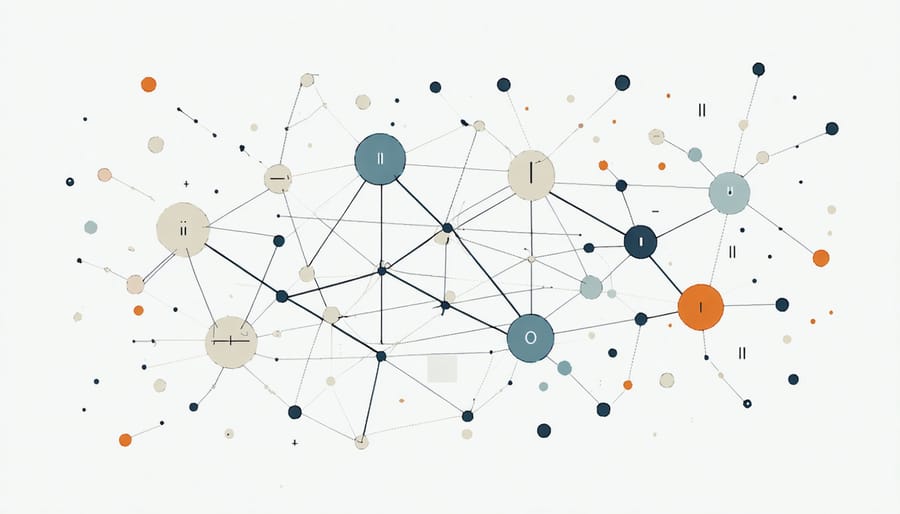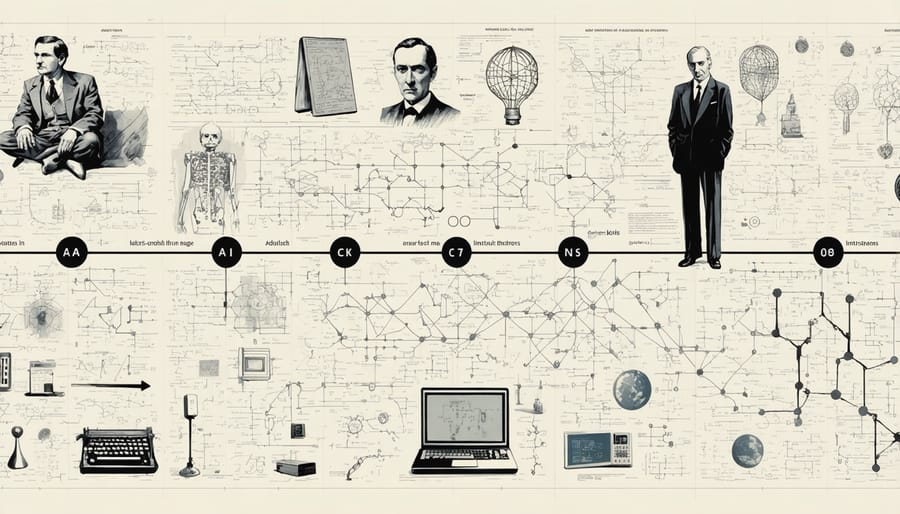From simple mathematical computations to sophisticated neural networks, artificial intelligence has undergone a remarkable transformation since its conceptual birth in the 1950s. The journey of AI technology represents one of humanity’s most ambitious endeavors: creating machines that can think and learn like humans. What began with Alan Turing’s groundbreaking question “Can machines think?” has evolved into a technological revolution that powers everything from smartphone assistants to autonomous vehicles.
The story of AI isn’t just about technological advancement; it’s a testament to human ingenuity and perseverance. Through decades of breakthroughs, setbacks, and “AI winters,” researchers and scientists have pushed the boundaries of what’s possible. From the early rule-based systems of the 1960s to today’s deep learning algorithms that can recognize faces, translate languages, and even create art, each development has built upon previous innovations to create increasingly sophisticated systems.
As we stand at the threshold of a new era in AI development, understanding its history becomes crucial for anyone seeking to grasp its future potential. This historical perspective not only illuminates how far we’ve come but also provides valuable insights into where this transformative technology is heading.
The Birth of Artificial Intelligence (1940s-1950s)

The Turing Test Revolution
In 1950, Alan Turing published his groundbreaking paper “Computing Machinery and Intelligence,” which would forever change how we think about artificial intelligence. The paper introduced what would later become known as the Turing Test, a revolutionary method for evaluating machine intelligence.
The test proposed a simple yet profound question: Can machines think? Rather than directly answering this philosophical question, Turing designed an imitation game. In this game, a human judge engages in text-based conversations with both a human and a machine, without knowing which is which. If the judge cannot reliably distinguish between the human and machine responses, the machine is said to have passed the test.
This elegant approach shifted the discussion from the abstract question of machine consciousness to the practical matter of behavioral intelligence. Turing predicted that by the year 2000, computers would be able to fool human judges 30% of the time during five-minute conversations – a prediction that proved remarkably accurate.
The Turing Test became more than just a measurement tool; it sparked crucial debates about the nature of intelligence and consciousness. While some critics argued that passing the test doesn’t prove true intelligence, its influence on AI development is undeniable. Modern chatbots and language models still draw inspiration from Turing’s vision, though they approach the challenge of human-like interaction in increasingly sophisticated ways.
The Dartmouth Conference
The summer of 1956 marked a pivotal moment in technological history when a group of visionary scientists gathered at Dartmouth College for what would become known as the birth of artificial intelligence. This groundbreaking eight-week conference, officially titled “The Dartmouth Summer Research Project on Artificial Intelligence,” was organized by John McCarthy, Marvin Minsky, Nathaniel Rochester, and Claude Shannon, who would later become influential figures among early AI research institutions.
The conference’s primary goal was ambitious yet straightforward: to explore ways machines could simulate human intelligence. It was here that the term “artificial intelligence” was officially coined by McCarthy, giving the field its enduring name. The participants spent their time discussing various aspects of intelligence and how it could be described precisely enough for a machine to simulate it.
While the conference didn’t immediately achieve its lofty goal of creating human-like artificial intelligence, it succeeded in establishing AI as a distinct academic discipline. The attendees’ discussions laid the groundwork for future research in areas like natural language processing, neural networks, and machine learning. The conference also fostered collaboration between researchers who would go on to establish major AI laboratories at institutions like MIT, Carnegie Mellon, and Stanford.
The Dartmouth Conference’s legacy continues to influence modern AI development, serving as a reminder of both the field’s ambitious origins and its ongoing pursuit of machine intelligence that mirrors human cognitive capabilities.
First Wave of AI Innovation (1960s-1970s)
Early Natural Language Processing
In the mid-1960s, natural language processing took a significant leap forward with the creation of ELIZA, a groundbreaking computer program developed by Joseph Weizenbaum at MIT. ELIZA simulated a psychotherapist by using pattern matching and simple rules to engage in text-based conversations with humans. While primitive by today’s standards, it was remarkably effective at creating the illusion of understanding and marked the first time many people experienced human-computer interaction through natural language.
ELIZA’s success sparked interest in developing more sophisticated language processing systems. In 1972, Kenneth Colby created PARRY, a program that simulated the behavior of a person with paranoid schizophrenia. When ELIZA and PARRY were made to converse with each other, the resulting interactions demonstrated both the potential and limitations of early natural language processing.
The 1970s saw the emergence of more structured approaches to language understanding. Terry Winograd’s SHRDLU program could understand and respond to natural language commands about a simple block world, demonstrating basic comprehension of context and grammar. This period also witnessed the development of various rule-based systems that could analyze sentence structure and extract meaning from text.
Despite their limitations, these early systems laid crucial groundwork for modern natural language processing. They helped researchers understand the complexity of human language and the challenges of teaching computers to interpret and generate meaningful responses. Their influence can still be seen in contemporary chatbots and virtual assistants, though today’s systems use far more sophisticated methods based on machine learning and neural networks.

Problem-Solving Programs
In the 1960s and 1970s, researchers made significant strides in developing early problem-solving systems that could tackle specific challenges in fields like mathematics, chemistry, and medical diagnosis. One of the most notable achievements was DENDRAL, created at Stanford University in 1965. This groundbreaking system could analyze mass spectrometry data to identify chemical compounds, making it the first successful expert system in scientific analysis.
Following DENDRAL’s success, MYCIN emerged in the early 1970s as a revolutionary medical diagnostic tool. It could identify bacterial infections and recommend antibiotics, achieving accuracy levels that sometimes surpassed those of practicing physicians. What made MYCIN particularly innovative was its ability to explain its reasoning process and handle uncertain information using confidence factors.
The General Problem Solver (GPS), developed by Newell, Shaw, and Simon, represented another milestone in AI’s evolution. This system could break down complex problems into smaller, manageable steps, much like human problem-solving approaches. While GPS had limitations, it laid the groundwork for modern planning algorithms and demonstrated how computers could simulate human reasoning patterns.
These early expert systems shared a common architecture: a knowledge base containing expert-derived rules and an inference engine that applied these rules to solve problems. Their success sparked widespread interest in AI applications across industries, leading to the development of numerous specialized problem-solving tools throughout the 1980s. Though limited by the technology of their time, these pioneering systems established fundamental principles that continue to influence modern AI development.
The AI Winter and Renaissance (1980s-1990s)

Neural Networks Revival
After a period of reduced interest in AI during the 1970s, neural networks experienced a remarkable comeback in the 1980s and 1990s. This revival was largely sparked by the introduction of the backpropagation algorithm, which solved one of the fundamental challenges in training multi-layer neural networks effectively.
The breakthrough came in 1986 when researchers David Rumelhart, Geoffrey Hinton, and Ronald Williams published their pivotal work on backpropagation. This algorithm allowed neural networks to learn from their mistakes and adjust their internal parameters automatically, making them practical for real-world applications for the first time.
This renaissance was further fueled by increasing computational power and the availability of larger datasets. The development of powerful graphics processing units (GPUs) in the 1990s provided the necessary hardware to train complex neural networks efficiently. Researchers could now experiment with larger networks and more sophisticated architectures than ever before.
Notable successes during this period included neural networks that could recognize handwritten digits with high accuracy and systems that could learn to play games. These achievements demonstrated the practical potential of neural networks and attracted renewed interest from both academia and industry.
The revival also benefited from theoretical advances in understanding how neural networks learn and represent information. Concepts like convolutional neural networks, introduced by Yann LeCun and others, proved particularly effective for image recognition tasks and laid the groundwork for modern deep learning systems.
This resurgence set the stage for the deep learning revolution that would follow in the 21st century, establishing neural networks as a cornerstone of modern artificial intelligence.
Expert Systems Evolution
Expert systems marked a significant milestone in AI development during the 1970s and 1980s, representing some of the first successful commercial applications of artificial intelligence. These specialized programs were designed to mimic human expert decision-making in specific domains, using a combination of if-then rules and extensive knowledge bases.
DENDRAL, developed at Stanford University in 1965, became the first expert system by helping chemists identify organic molecules. Its success paved the way for MYCIN in 1972, a groundbreaking medical diagnostic system that could identify bacterial infections and recommend antibiotics with accuracy rivaling human doctors.
The 1980s saw the widespread adoption of expert systems across industries. Notable examples included XCON, developed by Digital Equipment Corporation, which successfully configured computer systems, saving the company millions annually. Financial institutions implemented expert systems for loan assessment and fraud detection, while manufacturing companies used them for production scheduling and quality control.
These systems proved particularly valuable in situations where human expertise was scarce or expensive. They could preserve and distribute specialized knowledge, making expert-level decision-making more accessible. However, they also revealed important limitations. Expert systems worked well only within narrow domains and couldn’t adapt to new situations outside their programmed rules.
Despite these constraints, expert systems laid crucial groundwork for modern AI applications. Their development helped establish key principles in knowledge representation and reasoning that continue to influence contemporary AI systems. The lessons learned from their successes and limitations have shaped how we approach machine learning and artificial intelligence today, particularly in fields like automated decision support and diagnostic systems.
Machine Learning Emergence
Machine learning emerged as a groundbreaking approach to artificial intelligence in the 1950s and 1960s, marking a significant shift from rule-based systems to programs that could learn from experience. Arthur Samuel, while working at IBM, coined the term “machine learning” in 1959 and demonstrated its potential with his checkers-playing program that improved through self-play.
The development of the perceptron by Frank Rosenblatt in 1957 represented one of the earliest artificial neural networks. This simple algorithm could learn to classify visual patterns and laid the foundation for modern deep learning systems. Despite its limitations, the perceptron showed that machines could be trained rather than explicitly programmed.
During the 1960s, pattern recognition emerged as a key application of machine learning. Researchers developed algorithms that could identify handwritten characters and simple shapes, though with limited success by today’s standards. The DENDRAL program, created at Stanford in 1965, became one of the first expert systems to use machine learning for chemical analysis.
By the 1970s, decision tree learning algorithms appeared, offering a more interpretable approach to automated decision-making. ID3, developed by Ross Quinlan in 1979, could learn to classify examples based on their features and became widely used in various industries. These early achievements, though modest compared to modern systems, established the fundamental principles that would later revolutionize artificial intelligence and lead to today’s sophisticated machine learning applications.
The technological foundations laid during the 20th century continue to shape modern artificial intelligence in profound ways. The early theoretical frameworks developed by pioneers like Alan Turing and John McCarthy created the bedrock upon which today’s AI innovations are built. These foundational concepts have had a remarkable impact on modern AI systems, from the neural networks first conceived in the 1940s to the machine learning algorithms refined throughout the 1980s and 1990s.
The evolution of AI through the 20th century taught us invaluable lessons about both the potential and limitations of artificial intelligence. The early enthusiasm, followed by AI winters, demonstrated the importance of managing expectations while maintaining steady progress. Today’s breakthrough technologies, including deep learning, natural language processing, and computer vision, are direct descendants of these historical developments.
Perhaps most significantly, the ethical and philosophical questions raised during AI’s early years remain relevant today. The discussions about machine consciousness, the nature of intelligence, and the relationship between humans and machines continue to inform how we approach AI development in the 21st century. As we push the boundaries of what’s possible with AI, the wisdom gained from past successes and failures helps guide responsible innovation.
Looking back, we can see that each breakthrough, setback, and theoretical advancement contributed to the rich tapestry of modern AI technology. This legacy serves not just as a historical record, but as a continuous source of inspiration and learning for future developments in the field.

